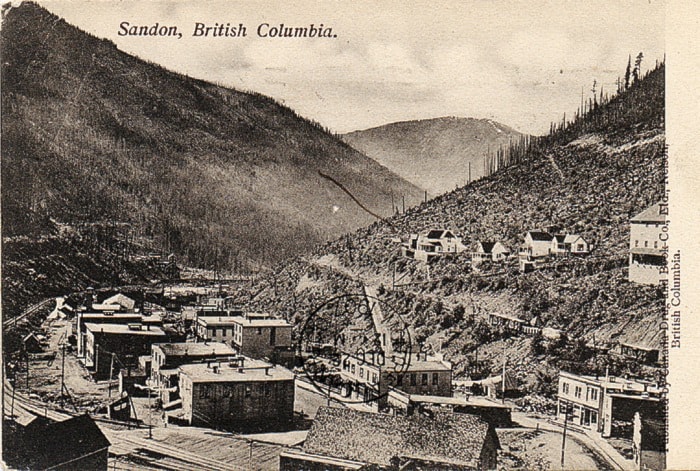The municipal landscape of the West Kootenay Boundary hasn’t changed in close to 40 years.
We have 17 municipalities — Castlegar, Creston, Fruitvale, Grand Forks, Greenwood, Kaslo, Midway, Montrose, Nakusp, Nelson, New Denver, Rossland, Salmo, Slocan, Silverton, Trail, and Warfield — and two regional districts, Central Kootenay and Kootenay Boundary.
But along the way we lost a few: two cities that went bust, plus a city, town, and district that amalgamated with their neighbours. Here’s a look at those five municipalities that ceased to be …
SANDON
West Kootenay’s best-known ghost town was incorporated as a city on either December 30, 1897 or January 1, 1898 depending on how you read the letters patent.
One of council’s first acts proved Sandon’s undoing, both physically and financially: they built a flume over Carpenter Creek, which ran through the centre of town, and paid for it by issuing a $15,000 debenture.
When it came due in 1913, practically no money was on hand, so the bankrupt city was placed in receivership. (This wasn’t unprecedented: Slocan was seized by the Crown for eight months in 1906-07 after a disastrous tax sale.)
A series of receivers took over, including former Nelson police chief Charles W. Young, helping Sandon out of the red. Receivership was finally lifted in 1919, but the new council must have struggled, for disincorporation followed on April 17, 1920.
In 1955, a washout plugged and wrecked the flume, badly undermining the town, and marking its end as a viable community. However, city hall, built in 1900, is still standing — it’s now the Prospector’s Pick, a gift shop.

PHOENIX
Incorporated as a city on October 11, 1900, the mining town between Grand Forks and Greenwood lived and died with the price of copper — which fell precipitously after World War I. The Granby Company closed its Phoenix mines and focused on operations at Anyox and Princeton, where many Phoenicians moved.
City council met for the last time in August 1920, and Phoenix was disincorporated on April 2, 1921, by which time the place was more or less deserted. Many buildings, including city hall, stood for decades, but all that’s left now is the cemetery and cenotaph.
During its brief life, Phoenix also claimed to be the highest incorporated city in Canada (no pot jokes, please), with an elevation between 4,361 and 4,603 feet (1,329 and 1,403 m). The title now belongs to Airdrie, Alberta, of all places, at 3,648 feet (1,112 m).
 COLUMBIA
COLUMBIA
The little-known and short-lived city of Columbia (that’s right: Columbia, British Columbia) was incorporated on May 4, 1899 in an area otherwise known as Upper or West Grand Forks.

Columbia and Grand Forks were bitter rivals: a Grand Forks restaurateur was jailed for making malicious statements about Columbia; the Columbia stage coach refused to let passengers off in Grand Forks; and Grand Forks founding mayor John Manly was accused of helping burn down a Columbia hotel. (The charges were dropped when a key witness failed to show.)
The feud finally ended in 1901 when residents of both cities voted to amalgamate, although it didn’t become official until January 1, 1903. Various names for the new city were suggested, including Amalga, Empire, and Miner. The latter secured the most support, but for some reason Grand Forks still won out.
The Columbia Grill, a train station-turned-restaurant, is about the only reminder of the erstwhile city.

TADANAC
On December 21, 1922, Tadanac broke away from Trail to become a Cominco-owned district municipality, encompassing the smelter and adjacent neighbourhood, home to company brass and certain professionals.
It raised a stink. The provincial Labour party claimed Cominco was trying to dodge municipal taxes by setting its own rates, a cry heard repeatedly for decades.

According to Elsie Turnbull in Trail Between Two Wars, “considerable opposition appeared among taxpayers in Trail,” but they were mollified after a mass meeting.
“Trail was to remain the commercial center. No churches or stores were to be built in the new municipality and only a small school for the lower grades.”
To further smooth the way for Tadanac sovereignty, Cominco agreed to make annual payments to Trail, cover half of all school costs, and help with the upkeep of parks and cemeteries.
Tadanac’s reeve and council would be elected by Cominco employees, although the candidates were usually company lawyers and executives.
It stayed that way until 1968, when amid much acrimony and threats of litigation, an amalgamation agreement was at last signed, and on January 1, 1969, Tadanac once again became part of Trail.
 KINNAIRD
KINNAIRD
For decades, Castlegar’s twin community followed it in lockstep like a younger sibling: Castlegar became a village in 1946; Kinnaird did the same on August 6, 1948. Castlegar became a town in 1966; so did Kinnaird, on August 5, 1967.
All the while though, there was talk of amalgamation, and it finally happened on January 1, 1974, following a referendum that earned over 67 per cent support.
Voters were then asked to name the new city, and it turned out local affection for Castlegar ran much deeper than for Kinnaird: Castlegar received 825 votes. Kinnaird received 11.
The two communities have since grown together to the point where the dividing line is invisible. Although now commonly called South Castlegar, Kinnaird lives on in the name of an elementary school, a former middle school, a church, and a hall.
One other bit of trivia: twin brothers Bob and Colin Maddocks served as mayors of Castlegar and Kinnaird, respectively — Bob from 1966-68 and Colin from 1970-73. Both sought election in 1969. Colin won, Bob lost.
